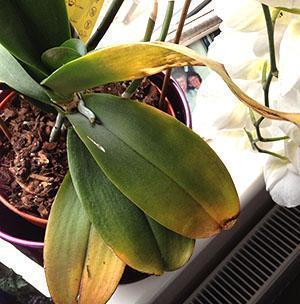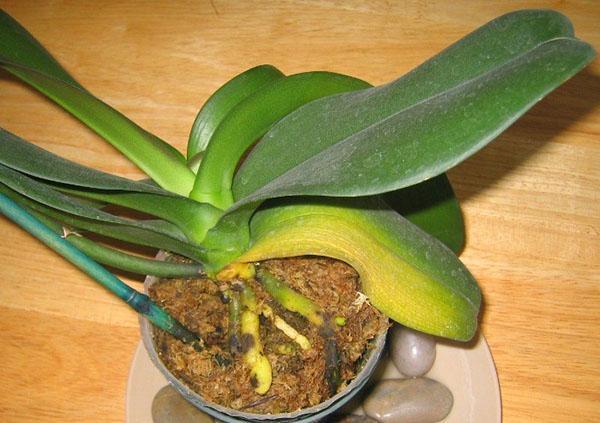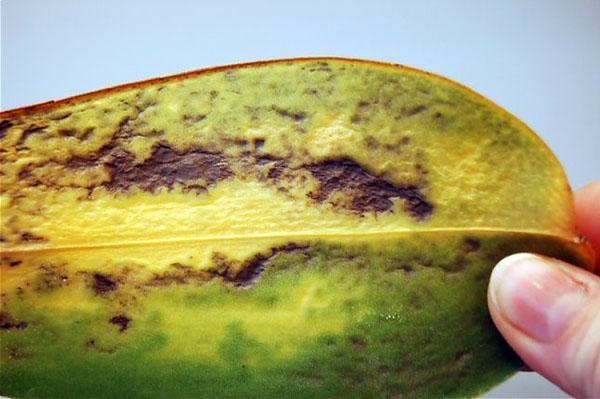A beautiful orchid fell ill - the leaves turn yellow
 Indoor orchids are predominantly indigenous to tropical and subtropical regions of the planet, requiring attentive and even reverent attitude. The answer to the question: "Why do the leaves of an orchid turn yellow?" in most cases, there are mistakes in care or a flower getting into uncomfortable conditions.
Indoor orchids are predominantly indigenous to tropical and subtropical regions of the planet, requiring attentive and even reverent attitude. The answer to the question: "Why do the leaves of an orchid turn yellow?" in most cases, there are mistakes in care or a flower getting into uncomfortable conditions.
Of course, plants are not eternal, and their foliage inevitably gives way to new ones. But when the leaves change color and wither en masse, it deserves the attention and concern of the indoor orchid lover.
For what reasons do orchid leaves turn yellow, and how to cope with such a serious problem? Almost all errors of the grower are reflected in the appearance of the plant. But most often, the flower's unhealthy is to blame:
- improper watering;
- incorrectly chosen place for a pot with an orchid;
- lack of nutrition or imbalance in the applied dressings;
- orchid diseases or attack by pests.
Orchid leaves turn yellow due to illiterate watering

What to do if the leaves of an orchid turn yellow? The solution to the problem will be to increase the volume of water entering the roots. If, before the appearance of yellowness, the florist practiced watering with a regular watering can, it makes sense to try to moisten the soil by immersion or under running water, allowing all excess moisture to drain off.
No less than artificial orchid drought damages the bay of the root system. In this case, the leaves do not dry out, but more often become limp, become lethargic and acquire a brownish-yellow unhealthy color. If you examine the roots, they often show signs of decay. Such a plant requires emergency assistance in the form of removing the affected areas and transplanting into a fresh substrate.
The cause of yellowed leaves is a lack or excess of sun
 A sign of a lack of sunlight is not only the stretching of the shoots, but the change in the color of the leaves from rich green to yellow. Moreover, the reaction of the flower is both gradual and sharp, up to the fall of the lower leaf plates. To prevent a situation when the leaves of an orchid turn yellow, you need to find a suitable place for the flower, and provide artificial lighting in winter.
A sign of a lack of sunlight is not only the stretching of the shoots, but the change in the color of the leaves from rich green to yellow. Moreover, the reaction of the flower is both gradual and sharp, up to the fall of the lower leaf plates. To prevent a situation when the leaves of an orchid turn yellow, you need to find a suitable place for the flower, and provide artificial lighting in winter.
Most orchid species require long daylight hours, but not in direct sunlight. With an excess of bright lighting in an orchid, the leaves turn yellow, becoming covered with drying spots of burns.
Orchid leaves turn yellow due to hard water and excess fertilizer
 Excessive salt content in irrigation water negatively affects the entire plant, but the leaves are the first to signal changes in conditions of detention and poor health. Sometimes it is difficult to determine the reason why the leaves of an orchid turn yellow. The appearance of the substrate and the pot can become a kind of hint. If they show traces of salt deposition in the form of whitish stains and plaque, an explanation for the yellowness has been found.
Excessive salt content in irrigation water negatively affects the entire plant, but the leaves are the first to signal changes in conditions of detention and poor health. Sometimes it is difficult to determine the reason why the leaves of an orchid turn yellow. The appearance of the substrate and the pot can become a kind of hint. If they show traces of salt deposition in the form of whitish stains and plaque, an explanation for the yellowness has been found.
Hard water provokes the development of chlorosis. Orchid leaves turn yellow, only veins remain green. Then the shoots are exposed, and the plant may die.
You can save a flower with the help of a transplant and a competently conducted foliar feeding, for which only specialized formulations are used.
It is not worth replanting a flowering orchid, but it will be very useful to carry out repeated washing of the substrate with a mixture of distilled and ordinary settled water. The same method of washing is used to treat an orchid that has suffered from an excess of fertilizer or the use of an unsuitable, unbalanced composition for feeding.
 What other reasons are causing the foliage color change? Why do orchid leaves turn yellow? There are really many factors pushing the plant to such behavior. This can be a natural reaction to a change of scenery, for example, after a purchase or as a result of seasonal changes that the owner did not notice.
What other reasons are causing the foliage color change? Why do orchid leaves turn yellow? There are really many factors pushing the plant to such behavior. This can be a natural reaction to a change of scenery, for example, after a purchase or as a result of seasonal changes that the owner did not notice.
Orchid leaves turn yellow if the pot in which the flower is located has long been small for it. In this case, the plant is carefully transferred to a larger container.
Orchid pest infections
 Regular waterlogging of the substrate is doubly dangerous for orchids, since it is fraught with the development of not only putrefactive, but also fungal infections. A weakened plant attracts mites and insect pests.
Regular waterlogging of the substrate is doubly dangerous for orchids, since it is fraught with the development of not only putrefactive, but also fungal infections. A weakened plant attracts mites and insect pests.
With the timely detection of a problem, when the leaves of the orchid turn yellow and wither, but the root system is still viable, after sanitization and irrigation with fungicide, the flower is transplanted into a new soil. Unfortunately, the infection spreads rapidly and can quickly lead to the death of an adult flowering specimen.
In dry air, spider mites and root mites attack indoor orchids. Pests affect shoots, rhizomes and leaf plates, becoming the reason why the leaves of the orchid turn yellow, and the plant itself is seriously weakened due to lack of nutrition.
 If the treatment with acaricidal preparations is not carried out in time, the flower loses its adult foliage, and the growth of a new one slows down. In the presence of soil pests, you should not limit yourself to spraying, it is much more effective to combine this procedure with a transplant.
If the treatment with acaricidal preparations is not carried out in time, the flower loses its adult foliage, and the growth of a new one slows down. In the presence of soil pests, you should not limit yourself to spraying, it is much more effective to combine this procedure with a transplant.
Hello! Please tell me what happened and how to proceed? Orchids have been blooming for a long time, letting out new leaves, but the old lower ones turn yellow! About two months ago there was the same problem, I transplanted them, but then everything started again ((what to do ... tell me !!!
If your blooming orchid has more than 6 leaves, then natural renewal is taking place. The root system cannot feed both the peduncle and a large number of leaves. The plant donates and preserves flowers. If there are few leaves and they disappear, you will have to sacrifice flowers to preserve the plant. Remove peduncles until the green mass is restored. Make a succinic acid solution and rub the leaves on both sides every day.
tell me what's wrong with us
Was the flower overfilled? You need to look at the roots of the orchid, if they have rotted, and cut off all damaged ones. I would remove the most affected leaves and transplant the bush into new soil with a lot of bark (its mail is not visible in the pot). Before planting, be sure to treat it with a fungicide against fungi and dry the plant for several hours.
Good day! Gave an orchid for March 8th. Within a month, all the buds and blossoming Flowers dried up. Also, the flower stalks themselves wither .. watering was carried out in this way: weekly immersed the pot in water at room rate for 20-25 minutes. (So it was written on the label) the green foliage is still normal, but on the largest top sheet, yellowness gradually appears. Please tell me what could be the reason and will it still bloom? After all, an excellent plant was brought from the store, it was wrapped in craft paper.
We need to see what is going on in the pot. Take out and check the roots for rotten ones. Treat with a fungicide if the problem is still in the roots or for prevention. Change the soil. The leaves can be rubbed with succinic acid. Leave the yellow leaf for now and watch.
Good afternoon, we bought an orchid and did not see in the store that its leaves were broken, they began to turn yellow, and the small buds that are still there also began to dry out, what to do
I would check the ground and roots and transplant the flower into fresh soil. If rotten roots are found, they must be removed, the slices must be sprinkled. The broken leaves, unfortunately, will not grow back, but the peduncle may not have enough nutrition due to problems with the roots. If the flower is sick, it is generally recommended to cut the flower stalks so that they do not take away the strength needed to recover from it.